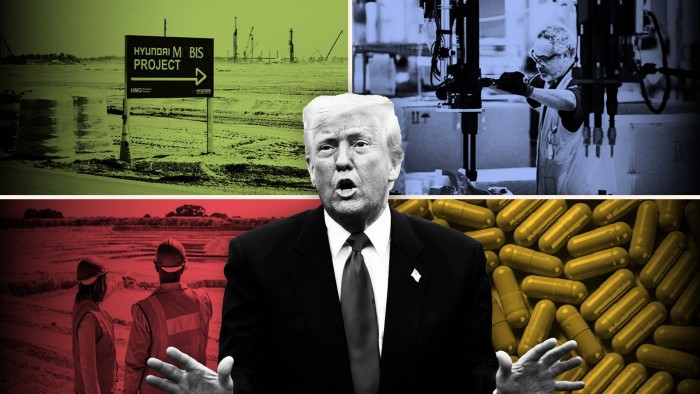From car factories to aluminium smelters, Donald Trump wants to bring manufacturing back to the US by waging the biggest trade war since the 1930s, but executives warn tariff uncertainty will make it too risky to invest billions of dollars in building new American plants.
“Reshoring” has been a top priority for the US president, with companies such as Apple, Diageo and Johnson & Johnson rushing to announce $1.9tn of investments in the US since his election, including bolstering their manufacturing capacity.
But the property search, design, and construction of a factory, along with permit applications and ordering robots and other manufacturing equipment, will mean plants take years to complete and many are unlikely to be finished before Trump’s second term expires.
“It will take between three and 10 years in most cases to build a new manufacturing facility in the US,” said Erin McLaughlin, an economist at the Conference Board who has a design and construction background. “Everything takes time before you can get that picture of a congressman with a shovel in their hand,” she added.
Companies looking to protect their supply chains may turn to domestic acquisitions instead of starting a new build, she said. “It might be faster to buy a company than to build a new plant.”
Given the long and costly process to build a factory, many executives are wary of immediately pouring money into new facilities while uncertainty persists over whether Trump will stick to his trade policy.
“The building of a plant will take years and then it’s going to be around for decades so you have to have a very long-term view of where regimes will go,” said Mark Wakefield, global automotive market lead at AlixPartners. “You’re not going to make a long-term decision today because you’re going to want to let things settle and see a bit more how things go.”
Market chaos unleashed by Trump’s tariff announcements last week has sparked criticism from billionaires such as investor Stanley Druckenmiller and Ken Langone, co-founder of Home Depot and longtime Republican donor, raising pressure to soften some of the levies.

On Tuesday, US Treasury secretary Scott Bessent told CNBC: “[CEOs] are not going to snap their fingers, find a greenfield site and build a factory but I am sure that the planning has already started in boardrooms because I spent the weekend talking to CEOs and investment bankers and that’s exactly what’s happening.”
Bessent added that he believed executives were still “putting together plans for when we finish these [trade] negotiations”.
In the case of cars, building a plant from scratch takes at least two to five years, according to industry executives. The time and cost depends on the size of the plant as well as whether key components such as powertrains and batteries will be produced in the same location.
South Korea’s Hyundai has invested $12.6bn to build an electric vehicle and battery cell plant in Georgia, which took about two and a half years from signing the deal until production began in October 2024. The state of Georgia and the local joint-development authority initially acquired the land in 2021, with the view to wooing Hyundai.
Even for a smaller plant, reaching production at scale can be slow and expensive. Volvo Cars has invested about $1.35bn in its plant in South Carolina since it picked the location in 2015.
The plant began production three years later and now has total annual production capacity of 150,000 vehicles, which some industry executives say is the minimum required to make it economically viable to build a new US plant.
Given the current uncertainty in the US, some companies may look to alternatives to building new factories. Wakefield said most carmakers had enough capacity at existing plants.
It would also be cheaper to restart mothballed facilities than to build new ones from scratch. Labour costs in the US mean that the factories will depend heavily on automation but ordering equipment also takes time, and tariffs are also set to increase the cost of overseas materials and technology.
General Motors told investors in February that it could not make decisions on where it would move its plants without policy clarity. “The market is pricing in a big impact of tariffs and lost profitability. Think about a world where, on top of that, we’re spending billions of dollars in capital and then it ends,” said GM’s finance chief Paul Jacobson.
Tariffs also risk making it more expensive to build new facilities. “Holding all else equal, tariffs will likely move costs higher,” said Daniel Ismail, managing director at real estate analyst Green Street.
The levies have hurt US non-residential construction by injecting uncertainty, according to Morgan Stanley analysts: “Non-residential construction spending . . . is likely to be the biggest victim of trade conflict uncertainty.”
Pharmaceuticals were excluded from the so-called reciprocal tariffs announced by Trump last week. In his Rose Garden speech, he praised companies that were expanding in the US and warned that drugmakers could expect a “big tax” if they failed to follow suit.
Building a factory that makes pills using standard equipment would take about three years, but complex facilities that make biologics such as chemotherapy or obesity drugs would take five, said Prashant Yadav, a supply chain expert at the New York-based think-tank the Council on Foreign Relations.
Even adding a new production suite in an existing plant could take about 18 months, he added.
Sweeping cuts to the US Food and Drug Administration risk delaying inspections and approvals required for pharmaceutical factories.
Nevertheless, some large pharmaceutical companies such as Johnson & Johnson and Eli Lilly have announced plans to significantly expand manufacturing in the US. One industry executive said these were often existing plans “embellished with bells and whistles” in an attempt to please the president.
Trump has also declared his ambition to “resurrect the American shipbuilding industry”. Once a leading shipbuilder, the US is now a tiny global player compared to some Asian countries.
Recommended
But experts say reviving American shipbuilding would require years of investment into new shipyards. The US has “zero” chance of becoming a significant shipbuilding nation during Trump’s second term, said Antonella Teodoro, a senior consultant at shipping advisory MDS Transmodal.
“On the optimistic side, it could take about five to 10 years to have a competitive facility up and running,” she said. “To achieve long-term success and compete globally, however, it might take longer.”
In metals production, the US had five active aluminium smelters in 2023, according to the US government.
To compete globally on aluminium production, the US would need to build smelters that can produce up to 1mn tonnes a year, said David Krakoff, a former executive at Kaiser Aluminum.
“You are talking about seven years until you start to see hot metal,” he added, given the permits and financing required to build a smelter of that scale.
Reporting by Patrick Temple-West, Kana Inagaki, Hannah Kuchler, Oliver Telling, Robert Wright, Joshua Oliver and Claire Bushey
This article has been amended to reflect that the Council on Foreign Relations’ headquarters are in New York, not Washington DC as originally stated.




